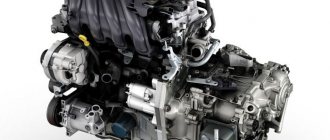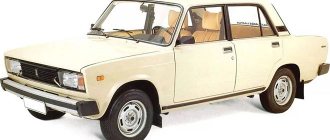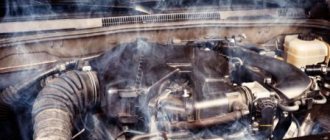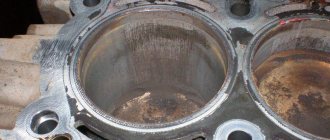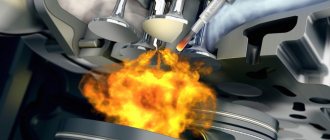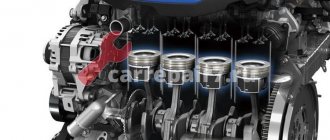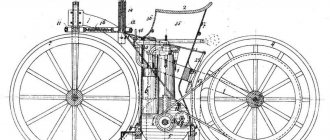Design nuances
To obtain the above engine characteristics, the manufacturer carried out experiments:
- piston stroke reduced to 66 mm;
- the cylinder diameter, on the contrary, is increased to 79 mm.
The result was a revving, powerful engine with an aluminum valve cover that absorbed the sounds of the drive. Another feature of the internal combustion engine is the fastening of the timing belt pulley - users do not need to unscrew the bolt on the crankshaft, unlike previous VAZ engine models.
Design 2105
In the operating instructions, the manufacturer recommends which oil to pour into the engine - 5W30 - 15W40.
Differences and advantages of the 2105 engine
Of course, this experimental project was supposed to be in many ways a better replacement for the engines of other popular VAZ models. In addition to the above-mentioned advantage in structure, the 2105 engine and the engine from the Ford Pinto together made a strong combination, which at one time was very popular and served car owners well. The lack of horsepower (64) was almost the only disadvantage of this mechanical combination:
- when operating at a high number of revolutions per minute, when engines 2101 and 2106 lost high torque, engine 2105 still worked;
- despite its lower power, its productivity beat its “rivals” precisely in terms of stability and speed of operation;
- This result was achieved precisely thanks to the structure of the pistons and the large diameter of the cylinder. This had a positive effect on productivity at high speeds.
Despite the obvious advantages, such an engine gas distribution mechanism, which was considered very productive throughout the world, did not take root in the CIS. This was due to the fact that he was supposedly less reliable than his predecessors. So, in 1994, the VAZ-2105 engine with a timing belt was removed from sale. The characteristics, which were clearly positive, could not change this, even after almost twenty years of testing in practice.
Indeed, there were still a number of troubles.
- Especially in choosing oil and traveling in winter.
- It could stall due to the oil thickening slightly at sub-zero temperatures.
- It needed to be warmed up.
At the same time, the characteristics of the VAZ-2105 engine with a timing belt are based on pistons with a small stroke: 66 mm. This indicates speed of operation, as does the cylinder diameter (79 mm). Of course, a number of negative aspects were very noticeable, but refusing to release a potentially global engine was a very wrong decision. It was easy to modify, but improvement requires work, effort and, most importantly, investment, while other engines already work well.
Characteristics and photos of the model are easy to find on the official website www.lada.ru. Perhaps in the future the automotive market will be more amenable to experimental solutions in favor of productivity, cheapness and comfort. But for now, use only the best!
Classic power units have different volumes and, accordingly, power. The VAZ 2105 engine is the first classic engine that had a belt drive for the gas distribution mechanism. The use of a belt drive had a beneficial effect on engine performance. Previously, a chain was used that made too much noise. Due to the use of an elastic belt, the noise level from the engine has decreased.
What cars were equipped with ICE 2105?
This modernization could not satisfy users of the domestic automobile industry. The main drawback was the regular breakage of the timing belt, AvtoAZ management reduced production volumes, then removed the 2105 engine from production, so only three modifications of the Zhiguli were equipped with the engine:
- 2105 sedan;
- 2104 station wagon;
- 21072 sedan.
Four with engine 2105
Currently, tuning for the engine of this series is not difficult, but among the operating fleet of Zhiguli “fives” with the “native” engine there are very few left.
Pros and cons
Subject to compliance with maintenance and operation regimes, major repairs were not required for the machines for decades. In capable hands, the 2105 engine produced in 1989 is still in use today, and the timing belt life is enough for 40,000 km. If there are no problems with consumables, then the demand for spare parts is not fully satisfied. For example, the cylinder head is always available, and the intake manifolds are welded on site.
Intake manifold
Some numbers
Two sedans: VAZ 2105, -07 and station wagon -04 represented a new line of VAZ classics, which replaced the “penny” generation (2101, -02, -03, -06). The first-born of this family, the 5th model was equipped with three power units:
Car model Engine index Volume, cm? Power, l. With. VAZ 21051 -2101 1200 60 VAZ 2105 -2105 1300 64 VAZ 21053 -2103 1500 75
Currently reading
How to maintain and charge a maintenance-free type of battery for...
ZIL 130 engine: a legend of the Soviet automobile industry
The 2105 engine was intended as a base engine. The weakest one was not particularly popular. The other two units have their supporters and opponents. Some technical characteristics of the “five” engine:
- The cylinder block is cast iron, unlined.
- The arrangement of 4 cylinders is in-line.
- Boring diameter - 79 mm.
- Piston displacement - 66 mm.
- Power* - 64 l. With. (note - at the beginning of the release the number 68 was indicated). Since there were no structural alterations, this was obviously caused by a change in the determination method.
- Torsion torque - 9.5 kgm at 3400 rpm.
- Volumetric compression - 8.8.
- Gasoline consumption AI-92: city - 10.2; track - 6.2; mixed cycle - 7.9.
Maintenance regulations
| Maintenance object | Time or mileage (whichever comes first) |
| Timing belt | replacement after 40,000 km |
| Battery | 1 year/20000 |
| Valve clearance | 2 years/20000 |
| Crankcase ventilation | 2 years/20000 |
| Belts that drive attachments | 2 years/20000 |
| Fuel line and tank cap | 2 years/40000 |
| Motor oil | 1 year/10000 |
| Oil filter | 1 year/10000 |
| Air filter | 1 – 2 years/20000 |
| Fuel filter | 4 years/20000 |
| Heating/Cooling Fittings and Hoses | 2 years/40000 |
| Coolant | 2 years/40000 |
| Oxygen sensor | — |
| Spark plug | 1 – 2 years/20000 |
| Exhaust manifold | 2 years |
Knowing what kind of oil is used in the engine and the type of liquid with which the cooling system is filled, you can carry out maintenance of the “five” internal combustion engine yourself.
Causes of malfunctions and their elimination
In principle, the 2105 engine has all the typical malfunctions of carburetor in-line internal combustion engines:
- clogging of the fuel system, fuel pump, carburetor, throttle, jets and filter;
- exhaustion of the life of the air filter and microswitch;
- failure of the ignition system and stuck valves and piston rings;
- breakdown of gaskets and seals, misadjustment of cam gaps;
- production of cylinders/pistons, bearing shells;
- loosening the flywheel bolts and attachment drive belts.
But the engine diagram allows you to avoid major repairs if the timing belt breaks by 100%.
Engine VAZ 2105 Zhiguli
- Repair manuals
- Repair manual for VAZ 2105 (Zhiguli) 1980-1992.
- Engine
4.0 Engine Longitudinal and transverse section of the engine 2105 Engine mounting 1 – support casing;
2 – front engine mount support; 3 – cylinder block flange; 4 – bracket; 5 – intermediate plate; 6 – insulating plastic ring; 7 – support spring; 8 – buffer; ... 4.1 Possible malfunctions, their causes and methods of elimination CAUSE SOLUTION METHOD Engine does not start No fuel in the carburetor: - fuel lines are clogged - wash and blow out the fuel tank, fuel lines - fuel pump is faulty - check the operation of the pump and replace damaged parts Faulty...
4.2 Removing and installing the engine PERFORMANCE ORDER 1. Place the car on a lift or over an inspection ditch, place stops under the front wheels and hang the rear axle on one or both sides. 2. Remove the hood, disconnect the wires from the battery and from electrical components installed on...
4.3 Disassembling the engine Disassembling the front part of the engine 1 – upper protective cover; 2 – tension roller; 3 – tension spring; 4 – camshaft drive belt; 5 – camshaft drive cover; 6 – drive shaft of the oil pump and ignition distributor; 7 – thrust flange;…
4.4 Engine assembly Marks on the main bearing caps and the conventional number of the cylinder block The bearings are counted from the front of the engine. Procedure for tightening the cylinder head bolts Installation of the oil pump drive gear and ignition distributor 1 – mandrel 41.78…
4.5 Bench testing of the engine The repaired engine is subjected to bench testing (run-in) without load according to the following cycle: 820 – 900 min –1 2 min 1000 min –1 3 min 1500 min –1 4 min 2000 min –1 5 min During the running-in of the repaired engine, no bring it to work...
4.6 Checking the engine on the car Install the engine on the car, carefully check the correct installation. Let the engine run for a while, then check: – for coolant and fuel leaks in the pipeline connections, tighten the connections if necessary; – is there any oil leakage; ...
4.7. Cylinder block (Category). See the list of materials inside...
4.8. Pistons and connecting rods (Category). See the list of materials inside...
4.9. Crankshaft and flywheel (Category). See the list of materials inside...
4.10. Cylinder head and valve train (Category). See the list of materials inside...
4.11. Camshaft and its drive (Category). See the list of materials inside...
4.12. Cooling system (Category). See the list of materials inside...
4.13. Lubrication system (Category). See the list of materials inside...
4.14. Power supply system (Category). See the list of materials inside...
4.15. Carburetor 2105-1107010 (Category). See the list of materials inside...
4.16. Carburetor 21051-1107010 (Category). See the list of materials inside...
↓ Comments ↓
1. Vehicle operation
1.0 Vehicle operation 1.1. Starting the engine 1.2 Controlling the gearbox 1.3 Driving the vehicle 1.4 Braking and parking 1.5 Operating a new vehicle 1.6 Adjusting the ignition timing 1.7 Precautions when operating the vehicle 1.8 Caring for the body 1.9 Storing the vehicle
2. Car maintenance
2.0 Vehicle maintenance 2.1 Maintenance operations
3. General information
3.0 General data 3.1 Technical characteristics of vehicles 3.2. Controls 3.3. Control of interior ventilation and heating 3.4 Tightening torques for threaded connections 3.5 Tools for repair and maintenance 3.6 Used fuels, lubricants and operating fluids 3.7 Basic data for adjustments and monitoring
4. Engine
4.0 Engine 4.1 Possible malfunctions, their causes and methods of elimination 4.2 Removing and installing the engine 4.3 Disassembling the engine 4.4 Assembling the engine 4.5 Bench tests of the engine 4.6 Checking the engine on the car 4.7. Cylinder block 4.8. Pistons and connecting rods 4.9. Crankshaft and flywheel 4.10. Cylinder head and valve mechanism 4.11. Camshaft and its drive 4.12. Cooling system 4.13. Lubrication system 4.14. Power system 4.15. Carburetor 2105-1107010 4.16. Carburetor 21051-1107010
5. Transmission
5.0 Transmission 5.1. Clutch 5.2. Gearbox 5.3. Cardan transmission 5.4. Rear axle
6. Chassis
6.0 Chassis 6.1. Front suspension 6.2. Rear suspension 6.3. Shock absorbers
7. Steering
7.0 Steering 7.1 Possible malfunctions, their causes and methods of elimination 7.2. Inspection, check and adjustment of the steering 7.3. Steering gear 7.4 Steering gear rods and ball joints 7.5 Bracket for pendulum arm
8. Brakes
8.0 Brakes 8.1 Possible malfunctions, their causes and methods of elimination 8.2. Checking and adjusting the brakes 8.3 Clutch and brake pedal bracket 8.4 Vacuum booster 8.5. Main cylinder 8.6. Front brakes 8.7. Rear brakes 8.8. Rear brake pressure regulator 8.9. Parking brake
9. Electrical equipment
9.0 Electrical equipment 9.1 Possible malfunctions, their causes and methods of elimination 9.2 Circuits protected by fuses 9.3. Battery 9.4. Generator 9.5. Starter 9.6. Ignition system 9.7. Lighting and light signaling 9.8. Sound signals 9.9. Windshield cleaner 9.11. Heater fan electric motor 9.12. Control devices 9.13. Carburetor pneumatic valve control system
10. Body
10.0 Body 10.1 Possible malfunctions, their causes and methods of elimination 10.2. Doors 10.3. Hood, trunk lid, bumpers 10.4. Body glazing, windshield and headlight glass washers 10.5 Instrument panel 10.6. Seats 10.7. Heater 10.8. Body frame repair 10.9. Paint coatings 10.10. Body anti-corrosion protection
11. Car modifications
11.0 Vehicle modifications 11.1. Features of repair of VAZ-21051 and VAZ-21053 cars 11.2. Features of repair of VAZ-2104 and VAZ-21043 cars 11.3 VAZ-21044 cars with a fuel injection system 11.4. Central fuel injection system design
12. Electrical circuits
12.0 Electrical diagrams 12.1 Interactive electrical diagram of the VAZ-2105 car 12.2 Electrical diagram of the VAZ-2104 car 12.3 Electrical connection diagram of the injection system 12.4 Connection diagram of the instrument cluster 12.5 Connection diagram of the brake system warning lamps 12.6 Connection diagram of the headlight cleaners and washers 12.7 Connection diagram of the heater fan motor 12.8 Diagram inclusion windshield cleaner and washer 12.9 Diagram for switching on direction indicators and hazard warning lights
Engine tuning
By analogy with the manufacturer’s previous internal combustion engines, the 2105 engine can increase power in several ways:
- boring the cylinders to fit the size of the larger piston;
- increasing the stroke length of the connecting rod;
- installation of a sports camshaft;
- installation of 4 or 2 carburetors;
- boring of cylinder head channels.
Tuning 2105
Thus, the ICE 2105 produced by AvtoVAZ was not produced for long. The engine consumed little oil; boosting it on its own was extremely difficult for Soviet-era motorists.
This is interesting: The design and principles of operation of the sensor
Some people like it hot
Young owners of VAZ “classics” sometimes tune their vehicles. Of course, a new body kit, straight-through exhaust or deafening music is not always enough. Therefore, they resort to modernizing the power unit.
The easiest way to tune the 2105 engine is to install the next generation DAAZ 21053 Solex carburetor. The increase, of course, will be insignificant.
A higher increase in power is provided by boring the cylinders and increasing the piston stroke. Possible options:
- Boring the cylinder bores to 82 mm increases the volume to 1400 cm³.
- Using the same pistons, but a longer crank (shaft 2103 with an 80 mm crank) and connecting rods shortened by 7 mm gives 1600 cubes.
- When both options are combined, the working volume becomes 1700 cm³. This tuning of the VAZ 2105 engine allows you to achieve a power of 100 hp. With.
A more radical way to improve technical characteristics is to replace the standard engine with a rotary power unit (VAZ 413 Wankel engine), produced at VAZ in small batches. Despite its small size, the tuning drive produces 140 horsepower. Of course, getting it is very problematic.
The engine with the VAZ 2105 index was underestimated because it was ahead of its time. It became the first domestic engine with a timing belt instead of a traditional chain. Time has shown the viability of this solution. On modern cars (especially small and middle class) belts are more common than chains. To a large extent, this was facilitated by the increase in the service life of these products.
